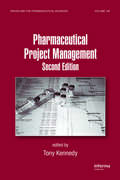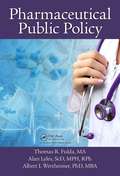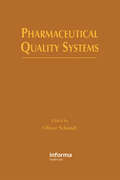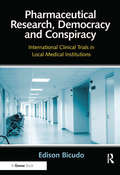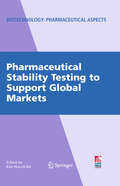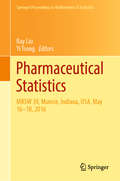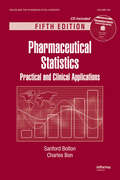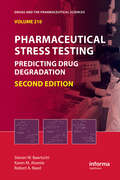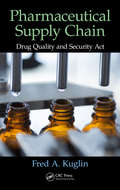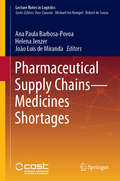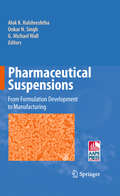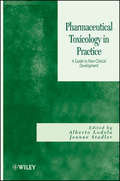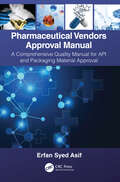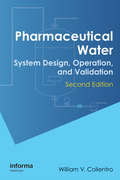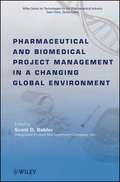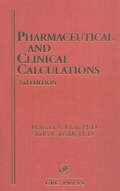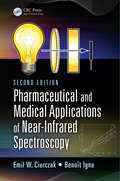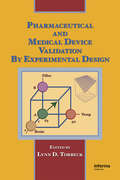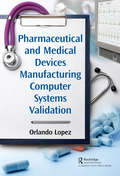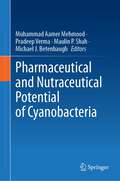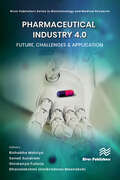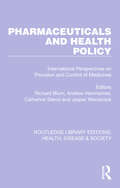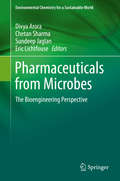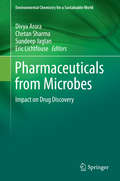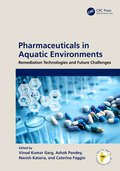- Table View
- List View
Pharmaceutical Project Management (ISSN)
by Tony KennedyEncompassing the full spectrum of project management's role and responsibility encountered in the pharmaceutical industry, Pharmaceutical Project Management outlines the key objectives, risks, and challenges of each stage of the pharmaceutical lifecycle, from discovery and preclinical phases through clinical development, manufacturing, registration
Pharmaceutical Public Policy
by Thomas R. Fulda Alan Lyles Albert I WertheimerAs the most common health-care intervention, prescription drug use shares the most important characteristics of the health-care system in the United States. When everything works well, it makes possible breathtakingly successful applications of science to the prevention and cure of human suffering. But everything doesn‘t always work well. Pharmaceu
Pharmaceutical Quality Systems
by Oliver SchmidtWhen a pharmaceutical company decides to build a Quality System, it has to face the fact that there aren't any guideline that define exactly how such a system has to be built. With terms such as quality system, quality assurance, and quality management used interchangeably, even defining the system's objectives is a problem. This book provides a pr
Pharmaceutical Research, Democracy and Conspiracy: International Clinical Trials in Local Medical Institutions
by Edison BicudoClinical trials used to be conducted overwhelmingly in the US and Europe but for a range of economic, technical and ethical reasons, the number of multicentre studies recruiting subjects in different regions of the World has grown exponentially. New medicines are tested in vast research networks involving several countries, hospitals and other medical institutions, and hundreds of individual subjects. In Pharmaceutical Research, Democracy and Conspiracy, Edison Bicudo examines the connections between global and local scales, exploring how it is possible for social actors as different as global companies and patients of local hospitals to come together and establish social relationships that may last many years. He also identifies the implications of these global-local relationships for the financial, technical and cultural structures of the participating hospitals. His study draws on fieldwork conducted in five countries: the UK, Spain, France, Brazil and South Africa. Shining a light on the social mediations that enable the encounter between these rationalities, the author concludes that this has the practical effect of subjecting countries hosting trials to institutional engineering. Hospitals and research agencies create new, sometimes surprising, institutional arrangements to cope with international research projects, which change relations between physicians and patients, as they acquire new roles as clinical investigators and research subjects. Frequently, such shifts deviate the institutional structures of medical institutions away from democratic, and towards conspiratorial, schemes. The book reviews the concept of mediation in sociological thought, proposes further developments in Habermas’ theory of communicative action, and offers some political reflection about the role of institutions in contemporary democracies.
Pharmaceutical Stability Testing to Support Global Markets
by Kim Huynh-BaThis book is a proceedings of the AAPS Stability Workshop. This workshop provide an understanding of the regulatory perspective of Stability Testing and position the stability program for 21st century globally by: Learning regulatory initiatives on global stability submission. Stability testing in challenging storage environment such as ASEAN or Caribbean region. Exploring concept of Quality by Design as it applies to stability testing. Understanding stability challenges of biologics, generics, nutraceutical, and other new product technology. Setting specifications for Drug Substances as well as various type of drug products. Exploring concerns on changes of stability profiles such as repackaged products, split tablets. Discussing safety and toxicology concerns of emerging impurities. Understanding physical effects on product stability. Stability to support temperature excursion during shipping. Assessing impurities and degradation product in development. Leveraging stability data to expedite regulatory approval. Managing relationship with Contract Research Organizations.
Pharmaceutical Statistics: MBSW 39, Muncie, Indiana, USA, May 16-18, 2016 (Springer Proceedings in Mathematics & Statistics #218)
by Yi Tsong Ray LiuThis book presents the proceedings of the 39th annual Midwest Biopharmaceutical Statistics Workshop (MBSW), held in Muncie, Indiana on May 16–18, 2016. It consists of selected peer- reviewed and revised papers on topics ranging from statistical applications in drug discovery and CMC to biomarkers, clinical trials, and statistical programming. All contributions feature original research, and together they cover the full spectrum of pharmaceutical R&D – with a special focus on emergent topics such as biosimilarity, bioequivalence, clinical trial design, and subgroup identification.Founded in 1978, the MBSW has provided a forum for statisticians to share knowledge, research, and applications on key statistical topics in pharmaceutical R&D for almost forty years, with the 2016 conference theme being “The Power and 3 I’s of Statistics: Innovation, Impact and Integrity.” The papers gathered here will be of interest to all researchers whose work involves the quantitative aspects of pharmaceutical research and development, including pharmaceutical statisticians who want to keep up-to-date with the latest trends, as well as academic statistics researchers looking for areas of application.
Pharmaceutical Statistics: Practical and Clinical Applications, Fifth Edition (Drugs and the Pharmaceutical Sciences)
by Sanford Bolton Charles BonThrough the use of practical examples and solutions, Pharmaceutical Statistics: Practical and Clinical Applications, Fifth Edition provides the most complete and comprehensive guide to the various statistical applications and research issues in the pharmaceutical industry, particularly in clinical trials and bioequivalence studies.
Pharmaceutical Stress Testing: Predicting Drug Degradation, Second Edition (ISSN)
by Steven W. Baertschi Karen M. Alsante Robert A. ReedThe second edition of Pharmaceutical Stress Testing: Predicting Drug Degradation provides a practical and scientific guide to designing, executing and interpreting stress testing studies for drug substance and drug product. This is the only guide available to tackle this subject in-depth. The Second Edition expands coverage from chemical stability
Pharmaceutical Supply Chain: Drug Quality and Security Act
by Fred A. KuglinError-proofing in the production process of pharmaceuticals isn‘t just a matter of good business, it has life-and-death implications for consumers. To that end, the 2013 Drug Quality and Security Act in large part requires new mandates on tracking and tracing chain of custody in the supply chain. Pharmaceutical Supply Chain: Drug Quality and Securi
Pharmaceutical Supply Chains - Medicines Shortages (Lecture Notes in Logistics)
by João Luís de Miranda Ana Paula Barbosa-Povoa Helena JenzerThis book provides an insight of relevant case studies and updated practices in “PharmaceuticalSupply Chains” (PharmSC) while addressing the most relevant topics within the COST Action “Medicines Shortages” (CA15105).The volume focuses on the most recent developments in the design, planning and scheduling ofPharmSC, broadening from the suppliers’ selection to the impact on patients and healthcaresystems, addressing uncertainty and risk mitigation, and computational issues. It is directed at MSc/PhD students and young researchers (Post-Docs) in Pharmaceutics/Pharmaceutical sciences, Engineering fields, Economics/Management, as well as pharmaceutical decision makers, managers, and practitioners, and advanced readers demanding a fresh approach to decision making for PharmSC. The contributed chapters are associated with the homonymous COST Training Schools (TS), and the book creates a better understanding of the Action “Medicines Shortages” challenges and opportunities.
Pharmaceutical Suspensions
by G. Michael Wall Alok K. Kulshreshtha Onkar N. SinghThe suspension dosage form has long been used for poorly soluble active ingredients for various therapeutic indications. Development of stable dispersions over the shelf life of the drug product continues to be a challenge on many fronts. A good understanding of fundamentals of disperse systems is essential in the development of a suitable pharmaceutical suspension. The development of suspension dosage form follows a very complicated path. The selection of the proper excipients (surfactants, viscosity imparting agents etc.) is important. The particle size distribution in the finished drug product dosage form is a critical parameter that significantly impacts the bioavailability and pharmacokinetics of the product. Appropriate analytical methodologies and instruments (chromatographs, viscometers, particle size analyzers, etc.) must be utilized to properly characterize the suspension formulation. The development process continues with a successful scale-up of the manufacturing process. Regulatory agencies around the world require clinical trials to establish the safety and efficacy of the drug product. All of this development work should culminate into a regulatory filing in accordance with regulatory guidelines. Pharmaceutical Suspensions, in its organization, follows the development approach used widely in the pharmaceutical industry. The primary focus of this book is on the classical disperse system - poorly soluble active pharmaceutical active dispersed in a suitable vehicle. After discussing various disperse systems, the theory of disperse systems and commonly used excipients, the remaining chapters in this textbook systematically detail the development of pharmaceutical suspensions, from pre-formulation stage to clinical development, regulatory submission and commercial manufacturing. Additionally, the emerging area of nano-suspensions as applied to pharmaceutical filed is also discussed. Each of the chapters in Pharmaceutical Suspensions was written independently by scientists skilled in their specific areas. Contributing authors represent a cross-sections of scholars from Academic Institutions, Pharmaceutical Industries and Regulatory Agency.
Pharmaceutical Toxicology in Practice
by Jeanne Stadler Alberto LodolaThis book describes, with references to key source materials, the background to, and conduct of, the principal nonclinical studies that are central to drug development. The chapters provide an understanding of the key components of the preclinical phase of drug development with a hands-on description, with core chapters addressing study conduct, types, and reporting. As such, it is a practical guide through toxicology testing and an up-to-date reference on current issues, new developments, and future directions in toxicology. Opening with a practical description of toxicology and its role in the development of pharmaceuticals, the book proceeds to detail international regulations (including the impact of the new REACH standards for chemical safety), interdisciplinary interactions among scientists in drug development, steps in toxicity testing, and risk management. Further, the book covers the methods of genetic toxicology (assays, genomics, in vivo screening) as a complement to "traditional" toxicology in the risk assessment and risk management of pharmaceuticals.
Pharmaceutical Vendors Approval Manual: A Comprehensive Quality Manual for API and Packaging Material Approval
by Erfan Syed AsifThis book provides stepwise guidance on how to evaluate, audit, qualify and approve an active pharmaceutical ingredient (API) and packaging material manufacturer and supplier to enhance the GMP within the industry. The book will also be beneficial for institutions conducting pharmaceutical technology courses in terms of GMP and GLP applications. The Pharmaceutical Vendors Approval Manual provides readers and front-line health care products manufacturers, R&D management and biotech laboratories all the information they need to know to develop a GMP-oriented industry with trained and skilled personnel and manufacture products that meet GMP and regulatory requirements. This book provides a simple, concise and easy to use reference tool covering basic quality concepts and the elements of vendor’s assessment, qualification and approval required by the pharmaceutical educational institutions and professional certification bodies. It is equally relevant to Quality Assurance officers, Quality Control Analysts, Quality Auditors and other personnel involved in GMP/GLP services in the company. The book will also be beneficial for the institutions conducting Pharmaceutical technology study courses in terms of GMP and GLP applications. This book provides readers and front-line health care products manufacturers, R&D management and biotech laboratories all the information they need to know to develop a GMP-oriented industry with trained and skilled personnel and manufacture products that meet GMP and regulatory requirements covers basic quality concepts and the elements of vendor’s assessment, qualification and approval required by the pharmaceutical educational institutions and professional certification bodies provides stepwise guidance on how to evaluate, audit, qualify and approve an API and packaging material manufacturer and supplier to enhance the GMP within the industry provides ready to use regulatory documentation, e.g. letter of commitment, questionnaire, SOP, etc. required for API and Packaging Materials contract Provided material can be easily tailored to incorporate changes to add in-house vendor’s qualification requirements. Erfan Syed Asif, Ph.D is a Senior Consultant at PharmEng Technology.
Pharmaceutical Water: System Design, Operation, and Validation, Second Edition
by William V. CollentroA major new work on all aspects of water, the most used raw material ingredient in the pharmaceutical and biotechnology industries-used as an excipient in pharmaceutical formulations, as a cleaning agent, and as a separately packaged product diluent.Drawing on the author's extensive field experience with more than 400 pharmaceutical and related wat
Pharmaceutical and Biomedical Project Management in a Changing Global Environment
by Scott D. Babler Sea N EkinsPharmaceutical and Biomedical Portfolio Management in a Changing Global Environment explores some of the critical forces at work today in the complex endeavour of pharmaceutical and medical product development. Written by experienced professionals, and including real-world approaches and best practice examples, this new title addresses three key areas - small molecules, large molecules, and medical devices - and provides hard-to-find, consolidated information relevant to and needed by pharmaceutical, biotech, and medical device company managers.
Pharmaceutical and Clinical Calculations (Pharmacy Education Series)
by Mansoor A. Kahn Indra K. ReddyPharmaceutical and clinical calculations are critical to the delivery of safe, effective, and competent patient care and professional practice. Pharmaceutical and Clinical Calculations, Second Edition addresses this crucial component, while emphasizing contemporary pharmacy practices. Presenting the information in a well-organized and easy-to-under
Pharmaceutical and Medical Applications of Near-Infrared Spectroscopy
by Emil W. Ciurczak Benoit IgneSince the completion of the first edition of this book, major developments have occurred in the pharmaceutical industry that have shaped the field of near-infrared (NIR) spectroscopy. A new initiative from the U.S. Food and Drug Administration (FDA) to modernize regulations of pharmaceutical manufacturing and drug quality has helped position NIR sp
Pharmaceutical and Medical Device Validation by Experimental Design
by Lynn D. TorbeckThis title demonstrates how designed experiments are the most scientific, efficient, and cost effective method of data collection for validation in a laboratory setting. Intended as a learn-by-example guide, Pharmaceutical and Medical Device Validation by Experimental Design demonstrates why designed experiments are the most logical and rational ap
Pharmaceutical and Medical Devices Manufacturing Computer Systems Validation
by Orlando LopezValidation of computer systems is the process that assures the formal assessment and report of quality and performance measures for all the life-cycle stages of software and system development, its implementation, qualification and acceptance, operation, modification, requalification, maintenance and retirement (PICS CSV PI 011-3). It is a process that demonstrates the compliance of computer systems functional and non-functional requirements, data integrity, regulated company procedures and safety requirements, industry standards, and applicable regulatory authority’s requirements. Compliance is a state of being in adherence to application-related standards or conventions or regulations in laws and similar prescriptions. This book, which is relevant to the pharmaceutical and medical devices regulated operations, provides practical information to assist in the computer validation to production systems, while highlighting and efficiently integrating worldwide regulation into the subject. A practical approach is presented to increase efficiency and to ensure that the validation of computer systems is correctly achieved.
Pharmaceutical and Nutraceutical Potential of Cyanobacteria
by Maulin P. Shah Pradeep Verma Michael J. Betenbaugh Muhammad Aamer MehmoodCyanobacteria are the extraordinary microbes that are believed to have started life on Earth. It's been billions of years since they colonized this planet. Now, the question arises, what has made them so successful? The answer to this question lies in their remarkable potential to survive unfavorable environments, their substantial ability to fix the atmospheric carbon through photosynthesis, and their amazing secondary metabolites having antioxidant, osmo-protectants, and stress-tolerance abilities. Research on cyanobacteria has shown that these secondary metabolites and the substantial photosynthetic rates of cyanobacteria can be exploited for environmental, industrial, nutraceutical, and pharmaceutical applications. This book “Pharmaceutical and Nutraceutical Potential of Cyanobacteria” is a collection of 14 book chapters that have covered almost all aspects related to the opportunities, challenges, and potential applications whileemploying cyanobacteria as feedstock for various industrial and environmental applications with a special focus on pharmaceutical and nutraceutical applications. Some sections have also covered the enhanced biosynthesis, extraction, storage, and marketing of the cyanobacterial bioactive compounds (phycobilins, carotenoids, fatty acids, amino acids), and applications of cyanobacteria as food/feed of the future. We believe that this book will provide substantial learning opportunities to the readers including graduate students, academicians, phycologists, policymakers, environmental entrepreneurs, and industrialists. This book could be included in SDG 12 publications.
Pharmaceutical industry 4.0: Future, Challenges & Application (River Publishers Series in Biotechnology and Medical Research)
by Rishabha Malviya Sonali Sundram Shivkanya Fuloria Dhanalekshmi Unnikrishnan MeenakshiThe pharmaceutical industry is on the cusp of a new age, with the need for personalized therapy, more complex production processes, smaller batch sizes and rising manufacturing costs. It is necessary to continuously adapt to the rapidly changing environment using novel technology and improved operational efficiency and flexibility. To achieve this, intelligent manufacturing seems to be a definite answer. Pharma 4.0 is a framework for adapting digital strategies to the unique contexts of pharmaceutical manufacturing. This book provides a deep insight into key technologies that will modernize pharmaceutical manufacturing and facilitate digital transformation. Throughout the book we discuss technologies, application and challenges for applying digital technology in pharmaceutical industry, including: • Focus on an overview of Industry 4.0 and its application in the pharmaceutical field • Most recent advances in the pharmaceutical industry • Understanding the concepts of emerging technology trends for drug discovery.
Pharmaceuticals and Health Policy: International Perspectives on Provision and Control of Medicines (Routledge Library Editions: Health, Disease and Society #5)
by Richard BlumOriginally published in 1981, this comprehensive volume is intended for medical economists, clinical pharmacologists, physicians, pharmacists and consumers, as well as planner and administrators who must determine relevant policy and legislation in the area of the provision of medicines. The contributors believe that the system of drugs provision can benefit from being studied, by policy revisions and evaluation of the outcomes of policy operations.
Pharmaceuticals from Microbes: Impact On Drug Discovery (Environmental Chemistry for a Sustainable World #28)
by Eric Lichtfouse Divya Arora Chetan Sharma Sundeep JaglanThis book has been assembled with the hope of being an authoritative, comprehensive, conceptually sound and highly informative compilation of recent advances describing the concepts of bioengineering in the field of microbiology. It comprises of seven chapters written by eminent authors in their respective fields. Topics included deal with the significant advancement of microbial technology with emphasis on drug delivery strategies for healthcare products, vaccine delivery, biotransformation approaches to generate new molecules, upstream/downstream processing of biopharmaceuticals. It serves as excellent reference material for researchers, students and academicians in the fields of biotechnology, microbiology and pharmaceutical sciences.
Pharmaceuticals from Microbes: Impact on Drug Discovery (Environmental Chemistry for a Sustainable World #28)
by Eric Lichtfouse Divya Arora Chetan Sharma Sundeep JaglanThis book deals with the noteworthy advancement in the production of bioactive metabolites from microbes and their pharmacological significance. It highlights the pharmacological potential of marine microbes and endophytic fungi and their bioactive secondary metabolites. Emphasis is also given on the significance of probiotics and their specialized molecules in human health and disease as well as their role in dietary intervention for reducing the risk of non-alcoholic fatty liver disease. This work also serves as excellent reference material for researchers, students and academicians in the field of natural product chemistry, pharmacology and applied microbiology.
Pharmaceuticals in Aquatic Environments: Remediation Technologies and Future Challenges
by Ashok Pandey Vinod Kumar Garg Navish Kataria Caterina FaggioThis book covers pharmaceutical residue dispersion in the aquatic environment and its toxic effect on living organisms. It discusses conventional and advanced remediation technologies such as the use of biomaterials for the sequestration of contaminants, nanotechnology, and phytoremediation. The book includes topics such as the removal of pharmaceutical and personal care product residues from water bodies, green chemistry, and legal regimens for pharmaceuticals in the aquatic environment. It also covers the application of modified biochar in pharmaceutical removal.FEATURES Explores the management of the environment through green chemistry Describes phytoremediation technology for decontamination of pharmaceutical-laden water and wastewater Covers the detection methods and quantification of pharmaceutical residues in various contaminated sources Discusses ecotoxicological aspects and risk assessment of pharmaceuticals in the aquatic environment Reviews degradation and treatment technologies including nanotechnology, biomaterials, and biochar This book is meant for pharmaceutical, toxicology, and environmental science industry experts and researchers.
